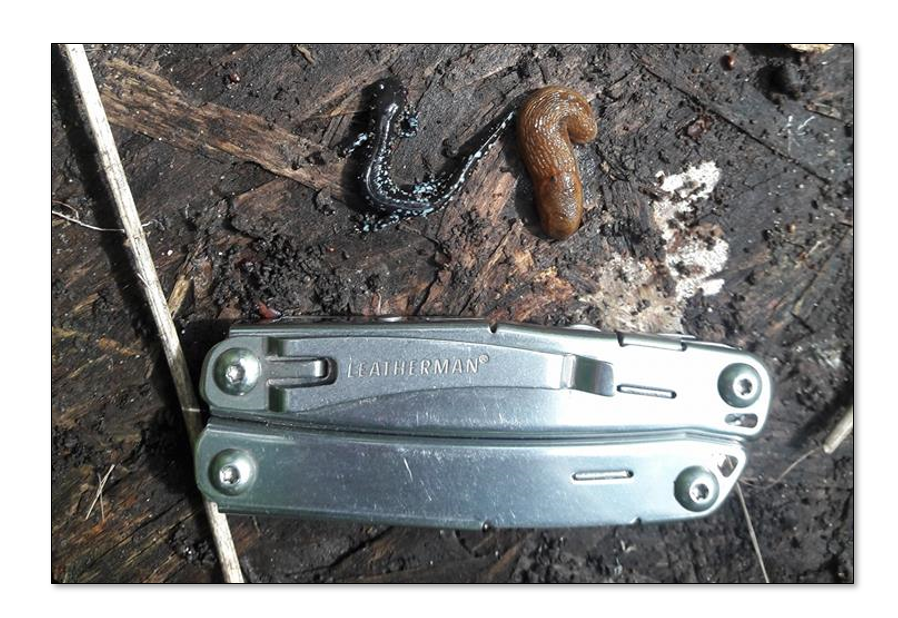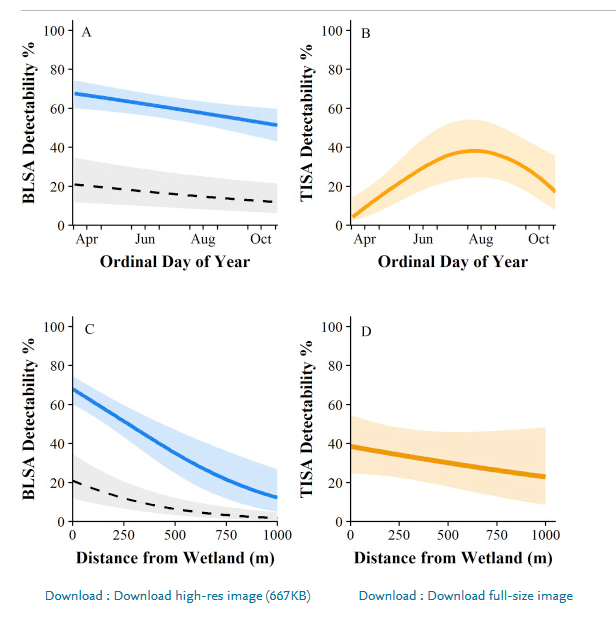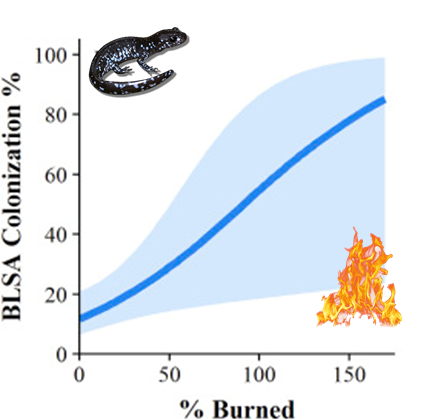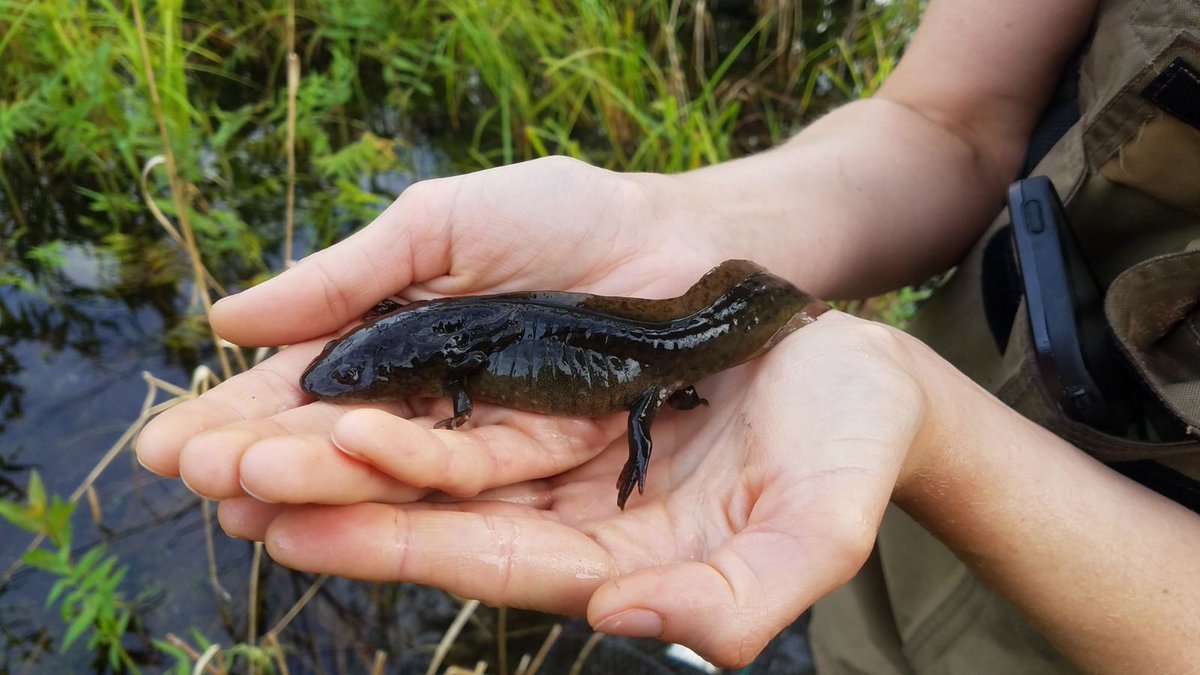Hey everyone, I thought I'd do a thread about our new Open Access paper: "Landscape and management factors influence the occupancy dynamics of sympatric salamanders in an urban preserve system"! doi.org/10.1016/j.gecc… 1/19
#ambystoma #chicago #urban_ecology #salamander @LCFPD
#ambystoma #chicago #urban_ecology #salamander @LCFPD

In this paper, we analyzed a decade of long-term monitoring data from nature preserves in the suburbs of Chicago, Lake County. Specifically, we looked at two species: (A): Blue-spotted Salamander (Ambystoma laterale) and (B): Eastern Tiger Salamander (A. tigrinum). 2/19 

Salamanders are poorly represented in the urban ecology literature, and our study site is a great place to study urban salamanders. Why? Lake County is one of the mostly densely populated counties in the United States! If that's not urban, I don't know what is! 3/19 



Using 10 years of monitoring data and occupancy modeling, we took a look at habitat use and responses to management. Using a method that incorporates imperfect detectability (like occupancy) is important, because as salamanders are cryptic and you can't always find them! 4/19 

So, we tried to figure out which factors influenced occupancy, detection, colonization, and extinction. We looked at landscape features like % tree cover, and management factors like time since last prescribed fire. 5/19 

Why prescribed fire? It's absolutely crucial if your goal is maintaining and restoring oak woodlands, prairies, and other native plant communities. Thus, a lot (over 2000 since the 1980s) of prescribed fire happens in @LCFPD preserves! 6/19 

Ok, so how did we survey for salamanders? We used artificial cover objects (plywood boards), which basically simulate logs or other nature cover objects salamanders might want to hide under. 7/19 

Coverboards are kind of a novel tool to sample for Ambystomatid salamanders; they are more commonly used to survey Plethodontids. But, lucky for us, they turned out to be very successful (at least for Blue-spotted Salamanders), resulting in surprisingly high detectabilty! 8/19 

So what about occupancy? Well, BLSA occupancy was quite high throughout the preserve distinct, and occupancy was strongly linked to landscape features such as tree cover and the presence of breeding wetlands. 9/19 

This wasn't the case for Tiger Salamanders though. For them, models with covariates, such as tree cover, were not ranked better than the null model. This makes sense, as Tigers in the midwest are generalists, while Blue-spotted Salamanders are habitat specialists. 10/19 



Now, what about management? Well, interesting results, to say the least! Prescribed fire seemed to be a good thing for Blue-spotted Salamanders. This makes sense, as fire is an important part of what keeps their habitat in good shape. 11/19 

And Tiger Salamanders? Well, no conclusive results. If anything, our results suggest prescribed fire may increase extinction rates! Much to ponder, but this wasn't a BACI design, so these results are just the first step towards really understanding what's going on. 12/19
However, one of the other results was that colonization increased with proximity to breeding wetlands for both species! This has implications for urban fragmentation and restoration: if you build it, they might not be able to come... 13/19 

Ok, so putting everything together: BLSA populations seem to be increasing, but this trend wouldn't be apparent if we ignored imperfect detection (gray dashed line). TISA populations might be decreasing, but the error bars are high. 14/19 

This baseline data is important if we want to detect declines, such as those from novel pathogens, like the salamander version of chytrid fungus (amphibiaweb.org/chytrid/Bsal.h…). Fortunately, Chicago isn't thought to be super vulnerable! 15/19 

Before I wrap up, one more note about detectabilty. Cover boards work well for surveying populations of Blue-spotted salamanders, but aren't that great for Tiger Salamanders. This will be a paper I hope get out later this year in HR or WSB. 16/19 

Finally what are the implications for urban ecology? First, if the habitat is there, Blue-spotted Salamanders can thrive in urban natural areas! Second, we can't treat all species the same. BLSA and TISA are similar species that occur sympatrically, but do different things! 17/19 

I always like to end with a "who cares?" Well, salamanders are a really cool thing to have around. Some cool research has shown they eat a lot of mosquito larvae, and might even be able to reduce mosquito densities! 18/19 

Thanks for reading, and thanks to all those who helped along the way, including the 5 anonymous reviewers. Now please cite this paper so I can get a job after I defend my dissertation! :) Cheers! 19/19 

• • •
Missing some Tweet in this thread? You can try to
force a refresh























